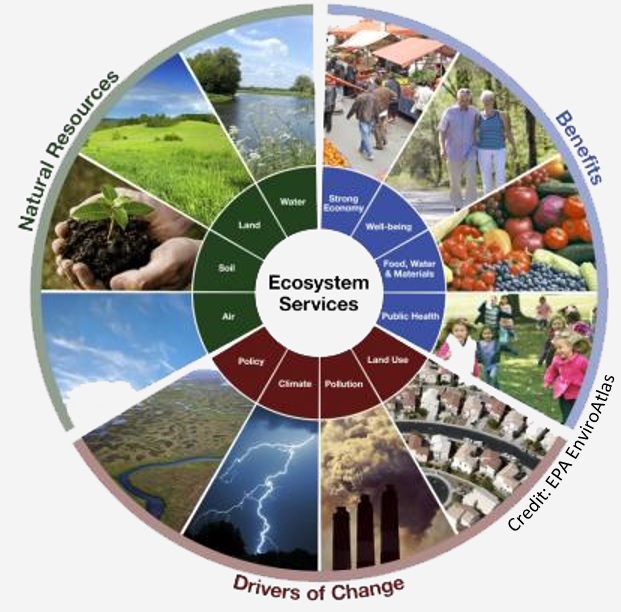 Wetlands provide a multitude of important goods and services for society, such as food, timber, flood attenuation, wildlife habitat, and carbon sequestration. The Millennium Ecosystem Assessment officially defines ecosystem services as “the benefits people obtain from ecosystems.” The emphasis provided by an ecosystem services perspective is on making an explicit link between the functions of nature (the natural processes that happen regardless of any resulting human benefit) and the subsequent benefits (goods and services) provided to society as a result of those functions. Goods are the tangible end products of ecosystem functions which are marketed and directly useable by humans (such as seafood, forage, timber, biomass fuels, natural fiber). Services are life-support functions, such as clean air, clean water, flood attenuation, carbon storage and sequestering, nutrient cycling, and biodiversity that are important to human welfare but are not accounted for in the consumer market. In other words, we do not directly pay for our use of them.
Wetlands provide a multitude of important goods and services for society, such as food, timber, flood attenuation, wildlife habitat, and carbon sequestration. The Millennium Ecosystem Assessment officially defines ecosystem services as “the benefits people obtain from ecosystems.” The emphasis provided by an ecosystem services perspective is on making an explicit link between the functions of nature (the natural processes that happen regardless of any resulting human benefit) and the subsequent benefits (goods and services) provided to society as a result of those functions. Goods are the tangible end products of ecosystem functions which are marketed and directly useable by humans (such as seafood, forage, timber, biomass fuels, natural fiber). Services are life-support functions, such as clean air, clean water, flood attenuation, carbon storage and sequestering, nutrient cycling, and biodiversity that are important to human welfare but are not accounted for in the consumer market. In other words, we do not directly pay for our use of them.
These services, however, are imperative for human welfare and survival, particularly in relation to the challenges we are beginning to face with climate change. Historically, those services have not been monetarily valued and therefore they have not been accounted for in the market system as a cost of production nor have we been able to monetarily quantify the value of their loss or their benefits to production or society. Since many policy and development decisions are based on monetary benefit-cost analysis, the value of wetland services (as non-commodities) has been absent from policy and development discussions and as a result, wetlands have been significantly degraded and destroyed.
NAWM conducted research into the ecosystem benefits attributed to wetland functions in general, and in connection to climate change adaptation strategies specifically, and compiled information regarding economic valuation methods for communicating wetland values: Ecosystem Service Valuation for Wetland Restoration: What It Is, How To Do It, and Best Practice Recommendations (2014)
